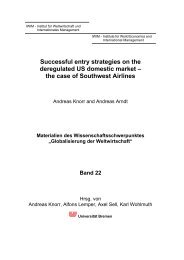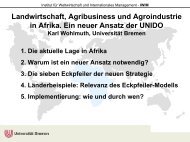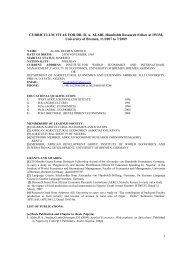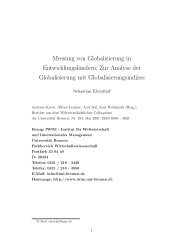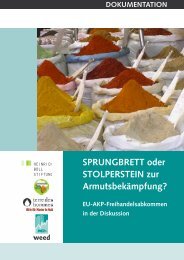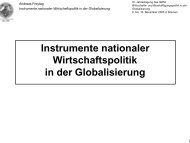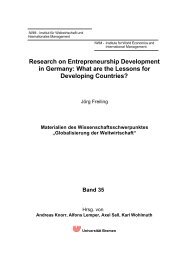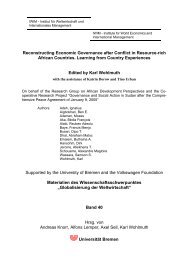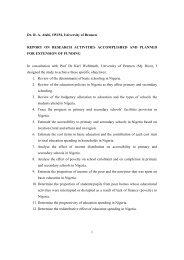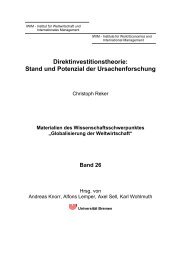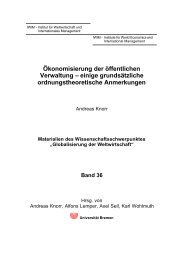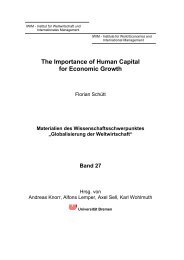Sectoral Analysis of Impact of Foreign Aid in Nigeria - Institute for ...
Sectoral Analysis of Impact of Foreign Aid in Nigeria - Institute for ...
Sectoral Analysis of Impact of Foreign Aid in Nigeria - Institute for ...
You also want an ePaper? Increase the reach of your titles
YUMPU automatically turns print PDFs into web optimized ePapers that Google loves.
7<br />
Moreover, World Bank (2005) reports that Iraq was the top recipient <strong>of</strong> development<br />
aid <strong>in</strong> 2005 followed by <strong>Nigeria</strong> 8 . However, this is due to the significant debt relief deals that<br />
were granted to these nations that year - when donor countries write <strong>of</strong>f a portion <strong>of</strong> a<br />
recipient country's debt, it is counted as ODA from the donor country. This expla<strong>in</strong>s high<br />
proportion <strong>of</strong> aid that went to <strong>Nigeria</strong> <strong>in</strong> 2005; <strong>Nigeria</strong> was granted debt cancellation <strong>of</strong> about<br />
19 billion US Dollars. This <strong>for</strong>m <strong>of</strong> aid is expected to have developmental impacts <strong>in</strong> <strong>Nigeria</strong><br />
as the money saved through the debt <strong>for</strong>giveness was channeled <strong>in</strong>to meet<strong>in</strong>g MDGs <strong>in</strong><br />
<strong>Nigeria</strong> (Alabi and Adam, 2011) 9 . So this fund is expected to have a higher impact on MDG<br />
focused sectors such as education, health and agriculture than other non-MDG focused<br />
sectors. Whether MDG focused sectors were more impacted by <strong>for</strong>eign aid or not needs be<br />
supported by evidence that will warrant a study <strong>of</strong> this nature. In addition, Njeru (2003) noted<br />
that it may be <strong>in</strong>terest<strong>in</strong>g to assess whether a dist<strong>in</strong>ction between bilateral and multilateral aid<br />
<strong>in</strong>fluences sectors <strong>of</strong> the economy differently, a feat which has not been attempted <strong>in</strong> Sub<br />
Sahara Africa. This study <strong>in</strong>tends to fill that vacuum.<br />
F<strong>in</strong>ally, Odusanya et al (2011) vividly revealed that <strong>for</strong>eign aid and government<br />
expenditure have contributed to economic growth <strong>in</strong> <strong>Nigeria</strong>, but that the impact has not been<br />
qualitative on the welfare <strong>of</strong> the <strong>Nigeria</strong>n populace. Consequently, they recommended that<br />
<strong>for</strong>eign aid and government expenditure should be judiciously utilized <strong>in</strong> provid<strong>in</strong>g necessary<br />
socio-economic <strong>in</strong>frastructure (adequate power, roads etc), required to stimulate economic<br />
growth and development at a satisfactory pace <strong>in</strong> <strong>Nigeria</strong>. However, this conclusion can be<br />
misplaced because they did not exam<strong>in</strong>e the impact <strong>of</strong> <strong>for</strong>eign aid on those sectors (powers,<br />
road, etc). For an objective conclusion to be drawn on which <strong>of</strong> the sectors to emphasize <strong>in</strong><br />
8 As a result <strong>of</strong> the oil boom, <strong>Nigeria</strong>’s per capita <strong>in</strong>come <strong>in</strong>creased sharply from US$250 <strong>in</strong> 1973 to US$1,000<br />
<strong>in</strong> 1980. This caused <strong>Nigeria</strong> to be classified as a middle-<strong>in</strong>come country and ODA assistance naturally<br />
decl<strong>in</strong>ed. The end <strong>of</strong> the oil boom and the economic crisis <strong>of</strong> the mid - 1980s led to a drastic fall <strong>in</strong> the per capita<br />
<strong>in</strong>come; <strong>Nigeria</strong> was then re-classified as a low-<strong>in</strong>come country <strong>in</strong> the year 1989. ODA flows have been<br />
<strong>in</strong>creas<strong>in</strong>g s<strong>in</strong>ce then (AFRODAD, 2005). For <strong>in</strong>stance, there was gradual reduction <strong>in</strong> the amount <strong>Nigeria</strong><br />
received as aid between 1970 and 1979 (from $590.47million to $28.92million), and it later rose to<br />
$473.63million <strong>in</strong> 1989. By 2005, <strong>Nigeria</strong> experienced a sharp <strong>in</strong>crease <strong>in</strong> the amount she received as aid. The<br />
value rose from $360.78million <strong>in</strong> 2004 to $6799.81 million <strong>in</strong> 2005. The follow<strong>in</strong>g year (2006) also witnessed<br />
almost the double amount <strong>of</strong> the amount she received <strong>in</strong> 2005; it rose to $11781.51million but later fell to<br />
$1385.2million <strong>in</strong> 2007. Appendix 3 <strong>in</strong>dicates that they were about $1401 million and $1638 million <strong>in</strong> 2008<br />
and 2009 at constant 2009 US dollars.<br />
9 After the US$19 billion debt owed by <strong>Nigeria</strong> to the Paris Club was successfully written <strong>of</strong>f by the creditors,<br />
the deal was to direct the sav<strong>in</strong>gs that the country would make from not hav<strong>in</strong>g to pay <strong>for</strong> the debts to pro-poor<br />
projects and programmes which would, <strong>in</strong> turn, assist <strong>in</strong> atta<strong>in</strong><strong>in</strong>g the Millennium Development Goals (Okeke,<br />
2009)



